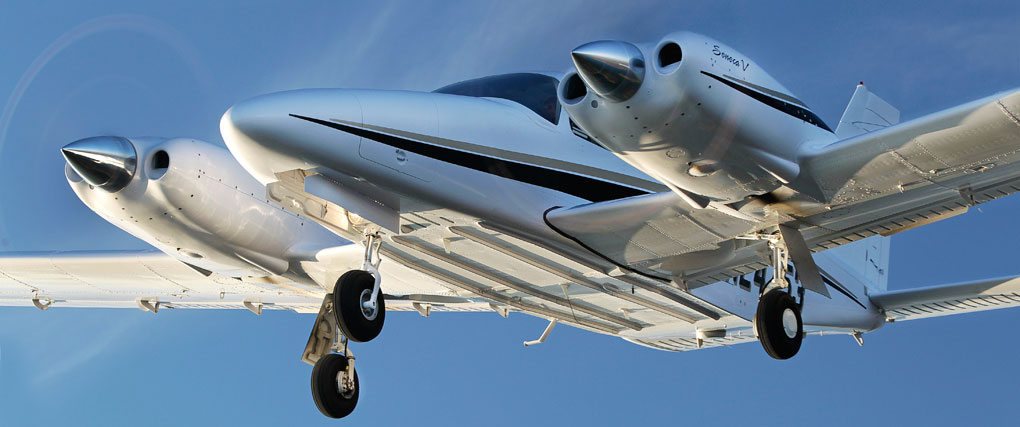
Photography by Chris Rose
A second engine brings a certain amount of comfort when there’s nothing around for hundreds of miles in any direction except Amazon rain forest. Welcome to the Piper Seneca V. South America—and Brazil, in particular—has been a haven for Seneca sales for decades. Piper’s strong presence in the region dates back to the days when a little Brazilian company called Embraer assembled Pipers to be sold in the region. Today, of course, Embraer is a global powerhouse, building everything from light jets to airliners and special-mission aircraft. Interestingly, today Embraer assembles Phenom business jets at a new factory just up the coast from Piper’s Vero Beach, Florida, headquarters while Piper no longer assembles aircraft in Brazil.
Although the global economy has morphed and shifted over the years, so has the Seneca. I earned a multiengine rating in a Seneca I, the only normally aspirated variant of the airplane and one that was wonderfully underpowered—wonderful for teaching multiengine neophytes about the limitations of light twins with only one propeller turning, that is.
The Seneca II and III introduced turbocharging and numerous other upgrades to the airframe. The Seneca IV, which debuted with the 1994 model, brought the most significant cosmetic change—round engine inlets. The Seneca V carried numerous enhancements including a step up to engines that could deliver 220 horsepower continuously (previous versions were limited to five minutes at that power, with 200 horsepower as max continuous); further refined round inlets that, along with a tuned induction system, improved cooling and reduced fuel consumption; much welcomed absolute pressure controllers on the turbo system; and most—visible to the pilot—twin stacks of new engine gauges and a flashy new digital engine monitoring system.
I was at the Piper factory for a glitzy rollout of the Seneca V in early 1997. A Bendix/King KLN-90B GPS and its stick-like monochromatic moving map mesmerized those of us who flew it. In following years, a duo of Garmin GNS 430s, each with its own color moving map, provided both navigation and communications. In later years the 1997’s mechanical six pack on each side was replaced—through the 2012 model—with dual Garmin G600 primary and multifunction flight displays, all interconnected to the S-Tec Fifty Five X autopilot system.
With the 2013 model out just this month, the S-Tec autopilot is about all that you will recognize from previous Seneca V panels. The all-black panel houses a new version of the Garmin G1000 cockpit suite so popular across the GA fleet. Among the new features of the new G1000 is the ability to program user-defined holding patterns at any point in space through a series of menu steps on the MFD. Choose your leg length by distance or time and the holding point in space ahead of you or along a radial—inbound or outbound—and the system will draw the holding pattern. With the autopilot engaged, the Seneca will use the proper entry method (that alone is worth the money!) and fly the hold. When your expect-further-clearance time is up, it will remind you of that, too. Watching the system draw, enter, and perfectly fly a hold—accounting for the winds—is a sight to be seen.
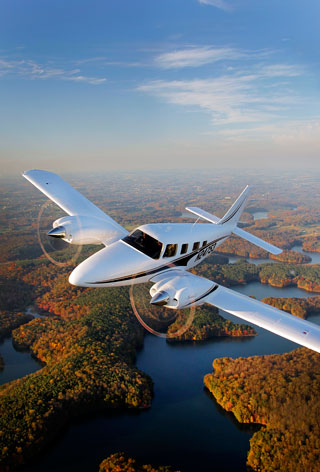
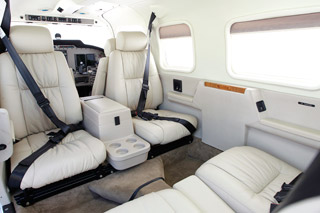
Also unique to the Seneca V, for now anyhow, is the use of an Aspen Avionics standby system that replaces all of the usual mechanical backup instruments normally required in a G1000 installation. With the primary battery, a backup battery, dual alternators, and battery backup on the Aspen system, you’d really have to work at having a total electrical failure in a Seneca V. The ship’s backup battery is always online powering an emergency bus, so if you lose the alternators and the primary battery, your load-shedding is already in effect; carry on.
The Seneca’s G1000 installation includes dual attitude and heading reference systems, further amping up the redundancy factor.
During my demo flight recently in Vero Beach, Piper Engineering Test Pilot John Kronsnoble pointed out the new engine monitoring displays along the left side of the MFD. Gone are the overlapping electronic engine-indicating needles used on most other twin-engine G1000 installations. Instead, Piper worked with Garmin to create individual left and right pointers for the various engine parameters, improving situational awareness for the pilot, especially in an engine-out situation. Similarly, the crew alerting system has been optimized to present simple and clear visual and audible messages to the pilot.
The post lights of yesteryear have all been replaced by LED panel floodlights and backlit placards. Also new to the Seneca V as a result of the G1000 upgrades is the optional Garmin Connect system, which those Brazilian pilots and others outside of North America will appreciate because it delivers global weather information via the installed Iridium satellite phone. The satellite phone also can be used for voice calls and text messages. North American pilots can opt for the more traditional Sirius XM satellite weather information through a Garmin GDL69.
Piper’s engineering staff has done an excellent job of marrying the capabilities of the S-Tec Fifty Five X to the G1000. However, starting in 2014, Piper will provide the Seneca V with the popular Garmin GFC 700 flight control system common with other G1000 installations.
According to Piper CEO Simon Calde-cott, the decision to install the G1000 in the Seneca V was market driven. Customers wanted it and the company saw an opportunity to take market share away from Beechcraft Corporation’s Baron G58. While Caldecott believes the piston-twin market is flat, he says the Seneca V—with its lower price and better fuel efficiency—can grab some share from the Baron, which has traditionally led the piston twin market outside the training arena, where the Piper Seminole is dominant. Base price for a Seneca V is about $972,000, some $300,000 less than that of a similarly equipped Baron.
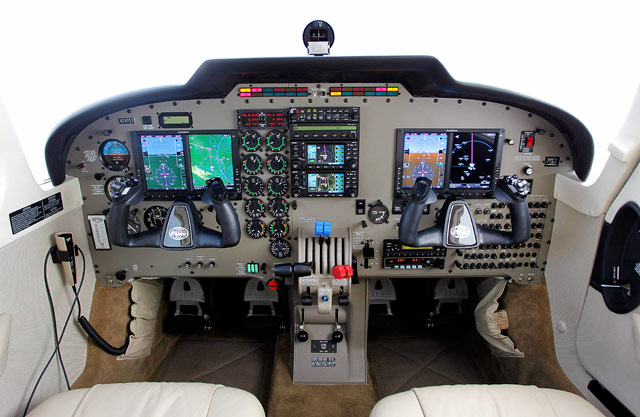
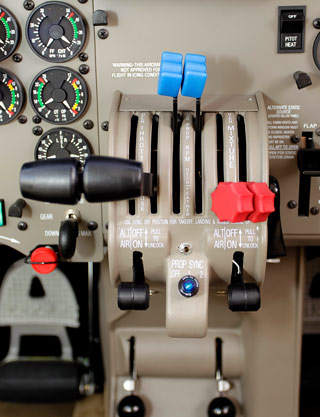
While digital data buses shuttle electrons effortlessly across today’s PA–34 panel, mechanically the airframe is as simple as ever. The fuselage is an upgraded version of the PA–32 that debuted with the Cherokee Six in the mid-1960s. Now, however, the four club seats in the back and the cockpit seats are stitched in soft leather. Extra soundproofing quiets the ride. Optional air conditioning cools the cabin. The nose baggage compartment can swallow up to 100 pounds of gear, as can the compartment behind the aft seats.
Tanks, carrying 61 gallons of usable fuel in each wing, feed the respective engines; a crossfeed system located between the pilot seats allows fuel balancing in the case of a failed engine. Engine-outs in Senecas have always been easy to handle, thanks to counterrotating engines. The turbocharged Continental TSIO-360 engines have proven reliable, especially thanks to the intercoolers and automatic wastegates. Earlier models had mechanical wastegates that invited ham-fisted pilots to overboost the engines. Now the pilot simply advances the throttle all the way forward for takeoff, giving the system permission to maintain maximum manifold pressure all the way to the maximum altitude of 25,000 feet. For that, you’ll want the optional built-in oxygen system.
Optional deicing boots allow for flight into known icing conditions. Garmin’s optional weather radar system and an L-3 Avionics Systems Stormscope give pilots additional weather-fighting tools.
Piper claims a maximum speed of 204 KTAS, possible at the maximum altitude of 25,000 feet. In the fall of 2012 I had the chance to fly a 2012 Seneca V with the G600 panel at 7,500 feet where at an intermediate cruise setting we saw 177 KTAS. There, at a turbine inlet temperature of 1,560 degrees F, 30 inches of manifold pressure, and 2,500 rpm the airplane was burning about 12.4 gallons per hour per side. An economy cruise of 27 inches and 2,300 rpm slowed us to 159 KTAS, but reduced fuel burn to 10.1 gph per side.
Sitting in the right seat, Rick Hesson, demo pilot for Piper dealer Skytech, suggested 120 knots on approach and a landing with just two notches of flaps—25 degrees. With that, I tugged the nose up for a nice touchdown. Senecas have always been heavier in pitch than in roll. On landing, that’s helped with a strategically placed suitcase in the aft baggage compartment.
Look for the first G1000-equipped Seneca Vs to show up at your local Piper dealer starting in April. For the past few years, nearly 100 percent of Senecas have been exported, but with the panel upgrade Piper plans to aggressively market the airplane domestically as well. Expect to see one in your neighborhood soon.

SPEC SHEET
Piper PA–34-220T Seneca V
BASE PRICE: $972,400
Price as tested: $1.15 million
Specifications
- Powerplants | Two Continental (L)TSIO-360-RB 220 hp @2,600 rpm | Recommended TBO | 1,800 hr
- Propellers | Two McCauley three-blade, 76-in dia
- Length | 28 ft 7 in
- Height | 9 ft 11 in
- Wingspan | 38 ft 11 in
- Wing area | 208.7 sq ft
- Wing loading | 22.7 lb/sq ft
- Power loading | 10.8 lb/hp
- Seats | 6
- Cabin length | 10 ft 4 in
- Cabin width | 4 ft 9 in
- Cabin height | 3 ft 6 in
- Empty weight | 3,442 lb
- Max ramp weight | 4,773 lb
- Max gross weight | 4,750 lb
- Useful load | 1,331 lb
- Payload w/full fuel | 599 lb
- Max takeoff weight | 4,750 lb
- Fuel capacity, std | 128 gal (122 gal usable)
- 768 lb (732 lb usable)
- Oil capacity, ea engine | 8 qt
- Baggage capacity | Nose 100 lb, 15.3 cu ft
- Aft 85 lb, 17.3 cu ft
Performance
- Takeoff distance, ground roll | 1,143 ft
- Takeoff distance over 50-ft obstacle | 1,707 ft
- Accelerate-stop distance | 2,065 ft
- Max demonstrated crosswind component | 17 kt
- Rate of climb, sea level | 1,455 fpm
- Single-engine ROC, sea level | 253 fpm
- Cruise speed/endurance w/45-min rsv, std fuel
- (fuel consumption) 25,000 ft
- @ high-speed cruise | 204 kt/3.2 hr | (156 pph/26 gph)
- @ normal cruise | 200 kt/4.3 hr | (144 pph/24 gph)
- Max operating altitude | 25,000 ft
- Service ceiling | 25,000 ft
- Single-engine service ceiling | 16,500 ft
- Landing distance over 50-ft obstacle | 2,180 ft
- Landing distance, ground roll | 1,400 ft
Limiting and Recommended Airspeeds
- VMC (min control w/one engine inoperative) | 66 KIAS
- VSSE (min intentional one-engine operation) | 85 KIAS
- VX (best angle of climb) | 83 KIAS
- VY (best rate of climb) | 88 KIAS
- VYSE (best single-engine rate of climb) | 88 KIAS
- VO (max operating manuevering speed) | 139 KIAS
- VFE (max flap extended) | 113 KIAS
- VLE (max gear extended) | 128 KIAS
- VLO (max gear operating)
- Extend | 128 KIAS
- Retract | 107 KIAS
- VNO (max structural cruising) | 164 KIAS
- VNE (never exceed) | 204 KIAS
- VR (rotation) | 81 KIAS
- VS1 (stall, clean) | 67 KIAS
- VSO (stall, in landing configuration) | 61 KIAS
For more information, contact Piper Aircraft, 2926 Piper Drive, Vero Beach, Florida 32960; 772-567-4361. www.piper.com
All specifications are based on manufacturer’s calculations. All performance figures are based on standard day, standard atmosphere, sea level, gross weight conditions unless otherwise noted.



